The trouble with real estate sales data is that it is invariably out of date. DataQuick’s stats for June, for example, consists of all sales that closed in June, mean that those sales were negotiated in May or even April. Furthermore, DQ takes its time getting the data all cleaned up, and by the time I get the June numbers it is almost the end of July. (I am looking into some ways to get a more timely if less precise picture of sales activity, but that’s not ready to go yet.)
Inventory data, on the other hand, is real-time. I can get the number of homes for sale right now. But while there is no lag, MLS inventory has its own issue: it only takes account of homes listed for resale on the MLS, excluding many units available in new developments.
I mention this not just as a reminder of the importance of looking at the market in many different ways, but also because it’s important to keep data limitations in mind while translating individual stats into a “big picture” interpretation of what’s going on. This is especially true when we see a bit of a divergence between sales data and inventory data—as we did this month.
Sales Activity
Median prices were pretty much flat (or, to be more accurate, they were up a bit for SFRs and down a bit for condos):
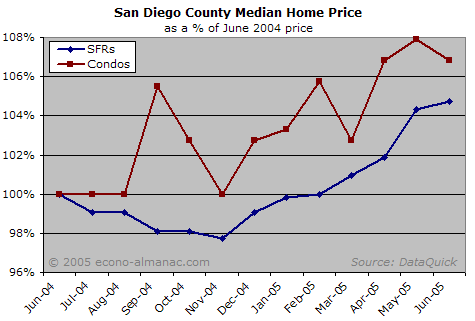
Unsurprisingly, the Breadth and Decliners Indices were fairly flat as well, indicating a continued price stability and lack of regional price declines:
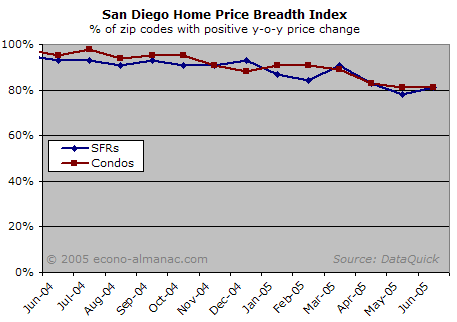
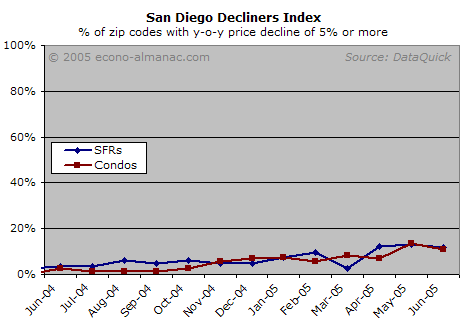
Sales volume looked healthy, as both home and condo sales came in respectably close to, though still under, their respective June 2004 numbers:
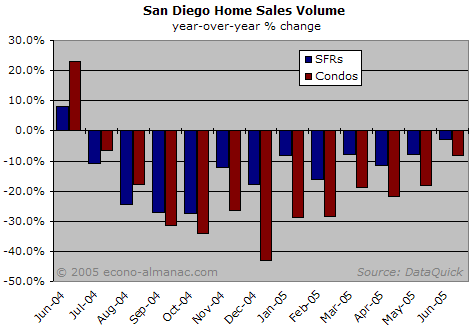
Overall, sales activity indicated a continued healthy level of housing demand during the May-June time period.
Inventory
For-sale inventory tells a less sanguine story. Inventory has been building since February, with a notable surge occuring during the month of July:
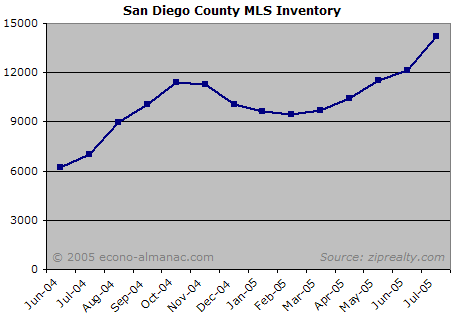
So, while sales are running at the same rate as they did last year at this time, inventory has more than doubled:
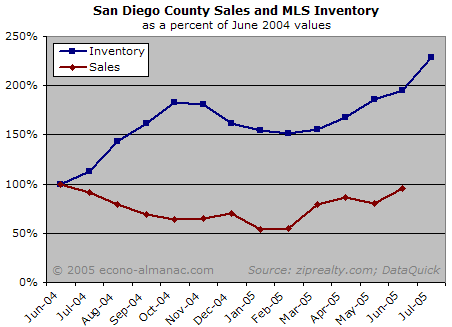
Inventory in our favorite hotbed of speculative fervor, Downtown, also continued its inexorable rise. Downtown inventory has almost doubled since March:

Conclusion
This is where it’s important to keep in mind the different timescales involved. The sales data indicates good, robust demand—in or around May. The inventory data shows a serious supply buildup as of July. What can we make of this data?
By definition, the inventory build means that more houses are coming onto the market than are being purchased. This means that while we don’t have explicit July home sale stats, we can infer flat or declining demand since the May timeframe. Therefore, it seems unlikely that prices will experience pressure to the upside.
Whether prices experience downside pressure depends less on the total amount of inventory than on the amount of “must-sell” inventory. Last year’s inventory stats bear this out—the huge increase in inventory from May-October really did not cause a notable price decline, because people who didn’t get the prices they wanted just took their homes off the market (hence the decline in inventory in late 2004). Given the benign conditions in the economy and credit market, it doesn’t seem likely that a lot of this inventory is of the must-sell variety.
So my best guess for now is more flatness in the near term. There is too much inventory for prices to go up very much, but economic conditions don’t indicate much downside pressure for the next couple months, either.
Thereafter things may get interesting as we hit the seasonal real estate slowdown. The slowing in demand could combine with the large inventory overhang to actually push the year-over-year price change figures into negative territory. Depending on how such an outcome was reported, it could cause some panic selling, which would be decidedly bad for the market. That looks like the biggest risk for right now (alongside the omnipresent risk of a bond market downturn). Barring that, the market should be pretty flat for the near future.
